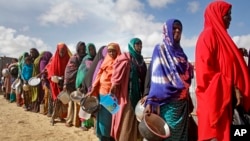Severe drought in Somalia is putting more than two million people at risk of starvation and forcing thousands out of villages and into a relief camp outside the capital. The United Nations has called for emergency aid to help those in need, including nearly a million Somali children facing hunger.
Tens of thousands of people seeking assistance have arrived in Mogadishu during the past three weeks due to lack of water and food.
Among them is Jowharo Mohamed, a mother of four who is expecting her fifth. But the scars and swelling on her body are not from pregnancy or childbirth. She says that after Somalia’s severe drought this year killed all her goats and cows, she walked over 100 kilometers (60 miles) from her village to a relief camp outside Mogadishu.
She says all the livestock died and life became so unbearable they could no longer stay there. So, they had to walk for 15 consecutive days and finally reached the camp.
The drought and loss of food production means hundreds of thousands of Somali children are suffering from hunger.
Among them is one-year-old Amina, whose growth has been severely stunted.
Amina's mother, Nima Ali Hassan, says her child has been suffering from malnourishment for the past six months. He has been suffering so much and the reason is because of the hardships, including the drought and lack of proper food, she added.
The United Nations warns Somalis need emergency aid or the country will face a major humanitarian crisis.
Head of the U.N. Office for the Coordination of Humanitarian Affairs in Somalia Justin Brady says that the situation is desperate.
“The levels of coping and resilience of these communities have been deteriorating and deteriorating over the last seasons. The government has stepped up to try and put in place a resilience and recovery framework to address the drivers of need. These are solutions that are not implemented overnight,” said Brady.
Somalia Humanitarian Affairs Ministry Director Mukhtar Hussein says more needs to be done at the local level to prevent displacement of those in need.
He says his ministry proposes and encourages people be helped while they can still cope, so they do not leave their homes and get uprooted, and is ready, as a ministry, to implement it.
In 2017, severe drought displaced almost one million Somalis, but a quick humanitarian response prevented famine.
While confidence is high that donors will help Somalia once again avoid mass starvation, Somalis already displaced will depend on aid until their lost means of making a living can be replaced.





